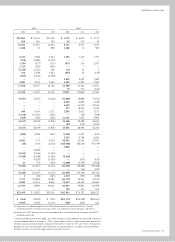GE 2012 Annual Report Download - page 69
Download and view the complete annual report
Please find page 69 of the 2012 GE annual report below. You can navigate through the pages in the report by either clicking on the pages listed below, or by using the keyword search tool below to find specific information within the annual report.management’s discussion and analsis
GE 2012 ANNUAL REPORT 67
credit carryforwards. We evaluate the recoverability of these
future tax deductions and credits by assessing the adequacy of
future expected taxable income from all sources, including rever-
sal of taxable temporary differences, forecasted operating
earnings and available tax planning strategies. These sources of
income rely heavily on estimates. We use our historical experi-
ence and our short- and long-range business forecasts to provide
insight. Further, our global and diversified business portfolio gives
us the opportunity to employ various prudent and feasible tax
planning strategies to facilitate the recoverability of future
deductions. Amounts recorded for deferred tax assets related to
non-U.S. net operating losses, net of valuation allowances, were
$4.8 billion at both December 31, 2012 and 2011, including
$0.8 billion and $0.9 billion at December 31, 2012 and 2011,
respectively, of deferred tax assets, net of valuation allowances,
associated with losses reported in discontinued operations,
primarily related to our loss on the sale of GE Money Japan. Such
year-end 2012 amounts are expected to be fully recoverable
within the applicable statutory expiration periods. To the extent
we do not consider it more likely than not that a deferred tax
asset will be recovered, a valuation allowance is established.
Further information on income taxes is provided in the
Operations—Overview section and in Note 14.
DERIVATIVES AND HEDGING. We use derivatives to manage a
variety of risks, including risks related to interest rates, foreign
exchange and commodity prices. Accounting for derivatives as
hedges requires that, at inception and over the term of the
arrangement, the hedged item and related derivative meet the
requirements for hedge accounting. The rules and interpretations
related to derivatives accounting are complex. Failure to apply
this complex guidance correctly will result in all changes in the
fair value of the derivative being reported in earnings, without
regard to the offsetting changes in the fair value of the
hedged item.
In evaluating whether a particular relationship qualifies for
hedge accounting, we test effectiveness at inception and each
reporting period thereafter by determining whether changes in
the fair value of the derivative offset, within a specified range,
changes in the fair value of the hedged item. If fair value changes
fail this test, we discontinue applying hedge accounting to that
relationship prospectively. Fair values of both the derivative
instrument and the hedged item are calculated using internal val-
uation models incorporating market-based assumptions, subject
to third-party confirmation, as applicable.
At December 31, 2012, derivative assets and liabilities were
$3.9 billion and $0.3 billion, respectively. Further information
about our use of derivatives is provided in Notes 1, 9, 21 and 22.
FAIR VALUE MEASUREMENTS. Assets and liabilities measured at fair
value every reporting period include investments in debt and
equity securities and derivatives. Assets that are not measured at
fair value every reporting period but that are subject to fair value
measurements in certain circumstances include loans and long-
lived assets that have been reduced to fair value when they are
held for sale, impaired loans that have been reduced based on
the fair value of the underlying collateral, cost and equity method
investments and long-lived assets that are written down to fair
value when they are impaired and the remeasurement of retained
investments in formerly consolidated subsidiaries upon a change
in control that results in deconsolidation of a subsidiary, if we sell
a controlling interest and retain a noncontrolling stake in the
entity. Assets that are written down to fair value when impaired
and retained investments are not subsequently adjusted to fair
value unless further impairment occurs.
A fair value measurement is determined as the price we would
receive to sell an asset or pay to transfer a liability in an orderly
transaction between market participants at the measurement
date. In the absence of active markets for the identical assets or
liabilities, such measurements involve developing assumptions
based on market observable data and, in the absence of such
data, internal information that is consistent with what market
participants would use in a hypothetical transaction that occurs
at the measurement date. The determination of fair value often
involves significant judgments about assumptions such as deter-
mining an appropriate discount rate that factors in both risk and
liquidity premiums, identifying the similarities and differences in
market transactions, weighting those differences accordingly and
then making the appropriate adjustments to those market trans-
actions to reflect the risks specific to our asset being valued.
Further information on fair value measurements is provided in
Notes 1, 21 and 22.
OTHER LOSS CONTINGENCIES are uncertain and unresolved mat-
ters that arise in the ordinary course of business and result from
events or actions by others that have the potential to result in a
future loss. Such contingencies include, but are not limited to,
environmental obligations, litigation, regulatory proceedings,
product quality and losses resulting from other events and
developments.
When a loss is considered probable and reasonably estimable,
we record a liability in the amount of our best estimate for the
ultimate loss. When there appears to be a range of possible costs
with equal likelihood, liabilities are based on the low end of such
range. However, the likelihood of a loss with respect to a par-
ticular contingency is often difficult to predict and determining
a meaningful estimate of the loss or a range of loss may not be
practicable based on the information available and the poten-
tial effect of future events and decisions by third parties that will
determine the ultimate resolution of the contingency. Moreover,
it is not uncommon for such matters to be resolved over many
























